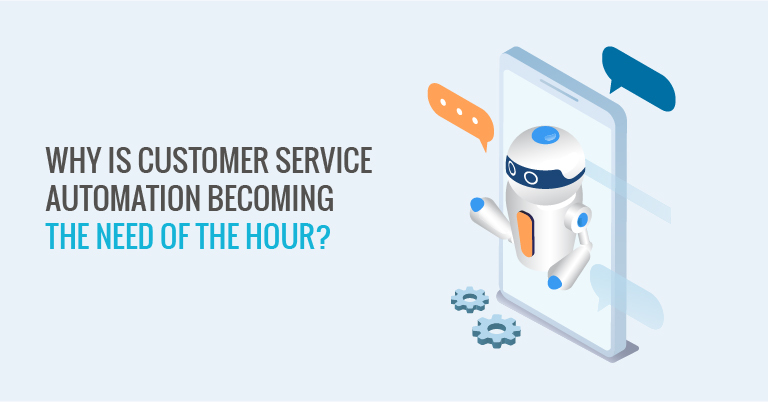
Why is customer service automation becoming the need of the hour?
Posted On: March 22, 2021
It takes 10 good experiences to make up for one bad customer experience and repair the customer-organization relationship.
Do you agree?
Gartner says, 85% of all customer interactions will be handled without human intervention.
Automated, self-service technologies such as AI chatbot, device guides, decision trees, and more; free up call center agents from answering repetitive customer queries and allow them to focus on more complex tasks
Automation is everywhere, in every industry and the customer service industry is no exception.
Self-service playbook Download now
Artificial intelligence (AI) is shaping contact centers
Advancements in digital technology continue to transform customer service interactions across industries. With AI today, complex customer queries are no longer a burden. Build a virtual assistant that allows your customers to easily search databases to find the answers they are looking for, eliminating the need to dig through standard operating procedures.
Further, answering customer questions faster, with accuracy helps agents get the job done smarter, all while reducing support costs. It enables resolution to your customer’s queries directly on the front end and provides your agents with the information and resources that they need on the back end.
End-to-end customer service with AI, enabling improvements in loyalty and brand reputation to new revenue streams. Real-time self-service and AI assistance in the customer service industry bring huge opportunities to forward-thinking businesses.
Automation can deliver a level of responsiveness that businesses could not even think otherwise. In the future, virtual assistants will be able to predict what your customers are looking for by analyzing how users are interacting with your brand. If your intelligent virtual assistant has an idea of who your customers really are, it will be able to deliver answers way before customers even know that they have concerns.
Advantages of customer service automation
1. Faster response time (FRT)
In an average service call, if you notice 75% of that time, agents are doing manual research while actual human customer interaction is limited to only 25%. This delay can be avoided entirely if AI could be used to go through company servers, previous occurrences of the related problem, and come up with a detailed guide or step-by-step solution.
Without a doubt, the quicker a problem is solved, the happier your customers will be. In fact, according to a study, 39% of customers try to solve a problem themselves by visiting the FAQ page first, before seeking the help of customer service.
The customer service desk can speed up service multifold by developing a virtual assistant to handle customer queries on the front end.
2. Proactive action
If the customer service desk can solve a problem before it even arises, it makes for a really happy and satisfied customer. AI has huge potential to analyze customer data, past interactions with agents, and identify frequent customer issues and problems by monitoring websites, and in-app activity for distress indicators.
3. Reliable, 24*7*365 customer service
Enabling automated customer service has the capabilities to respond to your customer’s queries within minutes. Customers don’t want to wait around for several hours or days for a response.
Connecting with your customers on a personal level even while using automation is the key factor to growth. A study showed that 42% of customers become repeat customers after a good customer service experience, whilst 52% stopped their purchases after a single poor customer service interaction.
4. Leaving no room for error
Automation removes or we can say minimizes the human element in this area of your customer service, which boosts the potential for idleness, futile effort, and human error.
5. Lesser cost
On the business end, on average, it takes $5000 to train a customer service agent, not to mention the monthly salary which you have to provide. On the flip side, AI needs to be trained once and it can be trusted to remember every one of its lessons.
6. Prioritizing queries
The simplest and most common queries can be handled by automated responses, FAQs, and step-by-step text as well as visual guides. However, for more serious and complicated support requests, you can implement a knowledge base software that enables self-service across all touchpoints.
7. Reduction in duplicate efforts
When a customer request is transferred to a new employee, the agent should get the records of the conversation that the customer was already having, along with probable solutions and guides.
Customers don’t like having to repeat their problems to a second or third person. According to a report by Capterra, 72% of customers blame a poor customer experience on having to explain their problem multiple times.
Because most companies have multiple communication channels, including instant chat on website and app, email, query submission pages, and phone automation, it’s mandatory to have a unified platform where all the data regarding a single query gets compiled, regardless of the channel it came in through.
This reduces duplication of effort for both the customer as well as a service agent.
The era of AI-powered customer engagement is now
An intelligent automation platform can redefine end-to-end customer interactions effectively too at a lower cost. This enables companies to create greater efficiencies, lower down customer handling time, and fully automate their business operations end-to-end.
Thus, the way forward, a key consideration should be implementing a solution that integrates business processes with artificial intelligence.



